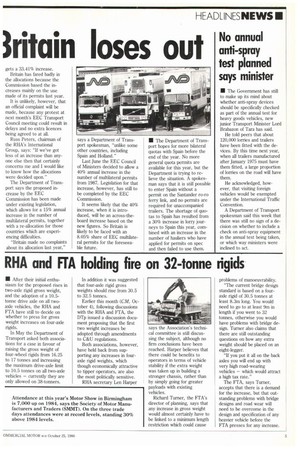RHA and FTA holding fire on 32-tonne rigids
Page 7

If you've noticed an error in this article please click here to report it so we can fix it.
• After their initial enthusiasm for the proposed rises in two-axle rigid gross weight, and the adoption of a 10.5tonne drive axle on all twoaxle vehicles, the RHA and FTA have still to decide on whether to press for gross weight increases on four-axle rigids.
In May the Department of Transport asked both associations for a case in favour of raising the gross weight of four-wheel rigids from 16.25 to 17 tonnes and increasing the maximum drive-axle limit to 10.5 tonnes on all two-axle vehicles — currently they are only allowed on 38-tonners. In addition it was suggested that four-axle rigid gross weights should rise from 30.5 to 32.5 tonnes.
Earlier this month (CM, October 4), following discussions with the FtHA and FTA, the DTp issued a discussion document proposing that the first two weight increases be adopted through amendments to C&U regulations.
Both associations, however, have held back from supporting any increases in fouraxle rigid weights, which though economically attractive to tipper operators, are also the most politically sensitive.
RHA secretary Len Harper says the Association's technical committee is still discussing the subject, although no firm conclusions have been reached. Harper believes that there could be benefits to operators in terms of vehicle stability if the extra weight was taken up in building a stronger chassis, rather than by simply going for greater payloads with existing vehicles.
Richard Turner, the FTA's director of planning, says that any increase in gross weight would almost certainly have to be linked to a minimum length restriction which could cause problems of manoeuvrability.
"The current bridge design standard is based on a fouraxle rigid of 30.5 tonnes at least 8.3m long. You would need to go to at least 9m in length if you went to 32 tonnes, otherwise you would have problems with bridge design. Turner also claims that there are still outstanding questions on how any extra weight should be placed on an eight-legger.
"If you put it all on the back axles you will end up with very high road-wearing vehicles — which would attract a high tax rate."
The FTA, says Turner, accepts that there is a demand for the increase, but that outstanding problems with bridge designs and road wear will need to be overcome in the design and specification of any heavier vehicle before the FTA presses for any increase.




































































































































